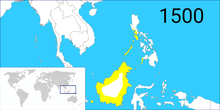 | |
| Horizon | Philippine history |
|---|---|
| Geographical range | Southeast Asia |
| Period | c. 900–1560s |
| Dates | c. Before 900 CE |
| Major sites | Tondo, Maynila, Pangasinan, Limestone tombs, Idjang citadels, Panay, Cebu (historical polity), Butuan (historical polity), Sanmalan, Sultanate of Maguindanao, Sultanate of Sulu, Ma-i, Bo-ol, Gold artifacts, Singhapala |
| Characteristics | Indianized kingdoms, Hindu and Buddhist Nations, Malay Sultanates |
| Preceded by | Prehistory of the Philippines |
| Followed by | Colonial era |
The recorded pre-colonial history of the Philippines begins with the creation of the Laguna Copperplate Inscription in 900 and ends with the beginning of Spanish colonization in 1565. The inscription records its date of creation in 822 Saka (900 CE). The discovery of this document marks the end of the prehistory of the Philippines at 900 AD. During this historical time period, the Philippine archipelago was home to numerous kingdoms and sultanates and was a part of the Indosphere and Sinosphere. [1] [2] [3] [4]
Contents
- Societal categories
- Social classes
- Laguna Copperplate Inscription
- Text
- Politics
- Emergence of Independent polities
- Other political systems by ethnic group
- Trade
- Indian influence
- Writing systems
- Earliest documented Chinese contact
- Arrival of Islam
- Beginnings
- Spanish expeditions
- First expedition
- Subsequent expeditions
- Conquest of the islands
- See also
- References
- Further reading
- External links
Sources of precolonial history include archeological findings; records from contact with the Song dynasty, the Brunei Sultanate, Korea, Japan, and Muslim traders; the genealogical records of Muslim rulers; accounts written by Spanish chroniclers in the 16th and 17th centuries; and cultural patterns that at the time had not yet been replaced through European influence.







